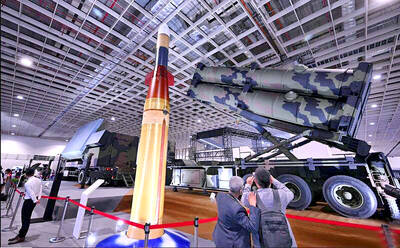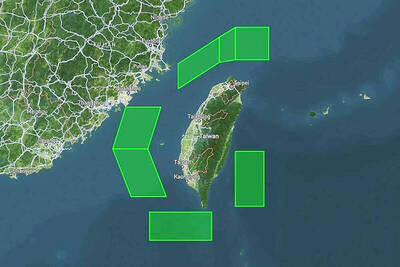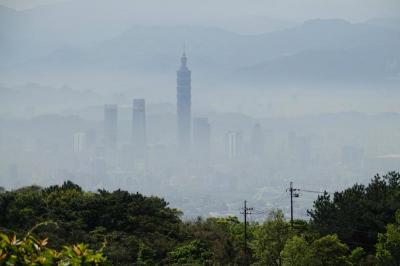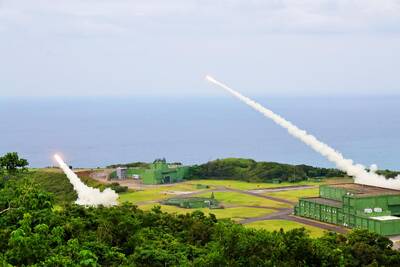Construction crews yesterday morning laid the first pier foundation for the Kinmen Bridge (金門大橋), the National Freeway Bureau said, adding that it is confident that the bridge would be finished by 2021.
The bridge would connect Greater Kinmen (大金門) and Lieyu (烈嶼, also known as Little Kinmen), the two main islands in the county, the bureau said.
It would span a strip of sea whose bed is on average 7m below the surface, it said, adding that in some areas the seabed is about 20m below the surface.
The geological complexity has made it impossible to lay the pier foundations using steel sheet piles, so the construction crews used the steel cofferdam method, the bureau said.
This was the first time the method was used by the bureau to lay a pier foundation, which took two months to complete, it said, adding that it should be able to lay the other pier foundations faster.
The bureau in March laid a foundation pile on granite.
The bureau yesterday explained the challenges of applying the steel cofferdam method.
The crews first installed jacketed steel pipes as a support base before beginning the construction, it said.
They assembled the steel cofferdam on land before lowering it to a designated depth using 12 large hydraulic jacks, the bureau said, adding that divers worked 3m to 9m below the sea surface to install bottom boards for the cofferdam and seal the plates between jacketed steel pipes.
Crews then pumped in concrete to form a 1.5m-thick bedding at the bottom of the cofferdam before pumping out the seawater trapped inside the structure, it said.
The cofferdam had to withstand buoyancy of more than 1,000 tonnes and tidal effects twice per day, the bureau said, adding that the crews installed six jacketed steel pipes and buoyancy-resistant steel piles to reinforce the structure.
Divers were kept on standby during the construction in case seawater leaked into the cofferdam, it said.
The bridge project has been criticized for “only surfacing during elections.”
The Legislative Yuan’s budget center has said in a report that the project had several issues, such as low budget implementation efficiency and construction delays.

Taiwan is to commence mass production of the Tien Kung (天弓, “Sky Bow”) III, IV and V missiles by the second quarter of this year if the legislature approves the government’s NT$1.25 trillion (US$39.78 billion) special defense budget, an official said yesterday. Commenting on condition of anonymity, a defense official with knowledge of the matter said that the advanced systems are expected to provide crucial capabilities against ballistic and cruise missiles for the proposed “T-Dome,” an advanced, multi-layered air defense network. The Tien Kung III is an air defense missile with a maximum interception altitude of 35km. The Tien Kung IV and V

The disruption of 941 flights in and out of Taiwan due to China’s large-scale military exercises was no accident, but rather the result of a “quasi-blockade” used to simulate creating the air and sea routes needed for an amphibious landing, a military expert said. The disruptions occurred on Tuesday and lasted about 10 hours as China conducted live-fire drills in the Taiwan Strait. The Civil Aviation Administration (CAA) said the exercises affected 857 international flights and 84 domestic flights, affecting more than 100,000 travelers. Su Tzu-yun (蘇紫雲), a research fellow at the government-sponsored Institute for National Defense and Security Research, said the air

A strong continental cold air mass is to bring pollutants to Taiwan from tomorrow, the Ministry of Environment said today, as it issued an “orange” air quality alert for most of the country. All of Taiwan except for Hualien and Taitung counties is to be under an “orange” air quality alert tomorrow, indicating air quality that is unhealthy for sensitive groups. In China, areas from Shandong to Shanghai have been enveloped in haze since Saturday, the ministry said in a news release. Yesterday, hourly concentrations of PM2.5 in these areas ranged from 65 to 160 micrograms per cubic meter (mg/m³), and pollutants were

Taiwan lacks effective and cost-efficient armaments to intercept rockets, making the planned “T-Dome” interception system necessary, two experts said on Tuesday. The concerns were raised after China’s military fired two waves of rockets during live-fire drills around Taiwan on Tuesday, part of two-day exercises code-named “Justice Mission 2025.” The first wave involved 17 rockets launched at 9am from Pingtan in China’s Fujian Province, according to Lieutenant General Hsieh Jih-sheng (謝日升) of the Office of the Deputy Chief of the General Staff for Intelligence at the Ministry of National Defense. Those rockets landed 70 nautical miles (129.6km) northeast of Keelung without flying over Taiwan,